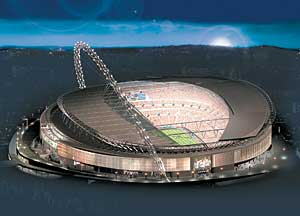Stadium Roofs Offer Much More Than Shelter
Learning Objectives:
- Discuss the configuration of several stadium roofs.
- Explain the structural components for various stadium roofs.
- Describe the design and construction challenges of an operable roof.
Credits:
Stadiums for professional sports and world-class competition are increasingly technically complex and high profile. Project teams design and build these facilities under the glare of the media, on tight schedules, and with financing often dependent on the largess of voters. "These projects are built in a fishbowl, especially if they are publicly run," says Dennis Wellner, AIA, a senior principle at HOK Sport, one of a handful of firms specializing in stadiums and arenas.
The addition of a roof to a stadium, along with the long-span structure required to support it and maintain clear sight lines from the stands to the playing field, compounds the pressures on the design and construction team responsible for an already challenging project. And an operable roof, which necessitates an enormous mechanical device at the top of the building, adds yet another layer of complexity. "Hire a good structural and mechanization consultant," advises one architect.
A roof, of course, can keep sports fans comfortable by keeping the elements out and conditioned air in. It provides a more flexible facility and allows owners to generate additional revenue by hosting a variety of events year-round. But it is much more than a means of satisfying these practical requirements. It also serves, in many cases, as the building's signature element.
A stadium with such a roof structure is under construction in London. There, architects Foster and Partners, along with HOK Sport, are replacing the 1920s era Wembley Stadium with a 90,000-seat facility with an iconic steel arch 400 feet tall and spanning 824 feet. Although the opening of the almost $1 billion soccer facility is still several months away, the arch is already serving as a landmark, and has been visible from distant parts of the city since its erection two years ago.
|
The lattice arch, which Wembley officials say is the longest single-span roof structure in the world, is made of 41 circular stiffening diaphragms linked by more than 500, 1-foot-6-inch-diameter spiraling steel tubes. The assembly, generally 24 feet in diameter, tapers to its supports on either side of the stadium. Cables anchored to the stadium's perimeter steelwork hold the arch with a slight northward lean.
Two roughly quarter-moon-shaped fixed-roof sections shelter the stadium interior. The arch supports the leading edge of the northern-roof section. From there, steel trusses span across the stadium, helping to support the southern roof. The roof over the field is open to the sky, permitting natural ventilation and sufficient sunlight for the natural grass turf to grow. However, the stadium can be completely enclosed in about 15 minutes with operable panels that extend from the southern fixed roof.
The contractor, Multiplex Construction U.K., is now due to hand over the stadium to the owner, Wembley National Stadium Ltd., this September, many months late. The construction process has suffered a litany of setbacks since the arch was assembled on the field and jacked into place two years ago, including a legal battle between Multiplex and a subcontractor, and skyrocketing steel prices. Earlier this year, Wembley officials decided to transfer last month's Soccer English Cup Final to another venue, since the stadium's completion looked uncertain.










